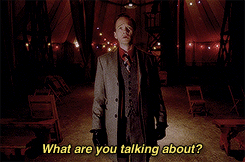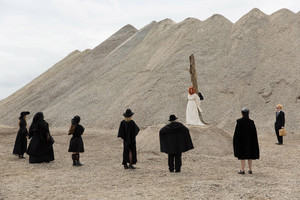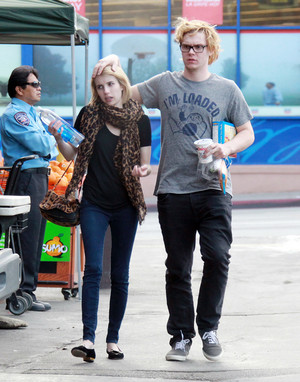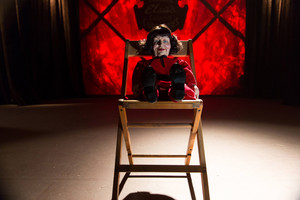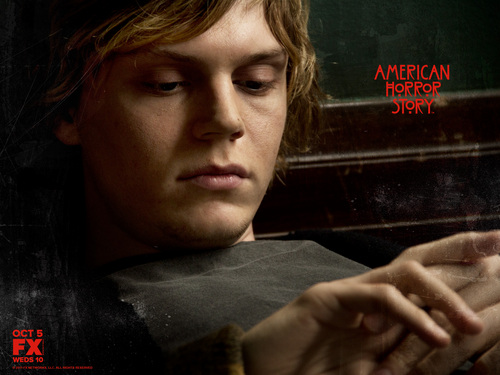Episode 04 | Aired Nov 7, 2012
Secrets are exposed as Anne Frank checks into The Asylum and goes gunning for a certain Nazi mad scientist
sejak Jeff Jensen at EW.com
She berkata her name was Anne Frank, and she wanted everyone to believe she was the Anne Frank, the Anne Frank of history, because she sincerely believed she was. Was she nuts? Possessed? Pulling a con in pursuit of some clandestine purpose? She was as dubious as Kit Walker claiming UFO abduction, yet she had proof. She had a death camp tattoo on her arm and memories of Auschwitz in her head, and a vivid recollection of one Nazi in particular, a creepy-sweet concentration camp doctor with a peculiar interest in girls, who lured them to his lab with Kandi and promises of salvation, who determined their fates with a flip of a coin. She knew him as Hans Gruber. We know him as Dr. Arthur Arden, the woman-hating dragon and science psycho of Briarcliff Manor, who in the freaky fiction of American Horror Story: Asylum is quickly becoming The Villain With A Thousand Faces, from Dr. Frankenstein to Dr. Strangelove, Stanley Kowalski to The Snake of Eden itself. “Hans Gruber” was the name of the counterfeit terrorist in Die Hard, while the coin flip evoked the Batman baddie Two-Face, a vengeful, self-righteous relativist. “I Am Anne Frank” was an episode of foul phonies with hideous biases and self-deceiving Heroes trying to survive and even redeem a culture poisoned from bias and corruption. As is often the case in stories about batty souls trapped in awful Arkhams where Truth has gone MIA, it was sometimes difficult to discern the difference.
It was also a story about the importance of knowing your history (personal and global), being honest about your identity, and sharing your story with others, no matter how hard atau shameful. In other words, “I Am Anne Frank” was about the importance of being… frank. And earnest and empathetic, too. In that spirit, let’s begin with some facts about the historical Anne Frank... atau at least, the facts that this all-controlling, context-shaping, allegedly trustworthy recapper wants anda to know. (Me = Dr. Thredson. Cue diabolical cackle!) Anne Frank was born in Germany in 1929 and moved to Amsterdam with her family in 1933. She spent two years in a “secret annex” hiding from the Nazi death machine. She had a noble spirit. (“How lovely to think that no one need wait a moment, we can start now, start slowly changing the world! How lovely that everyone, great and small, can make their contribution toward introducing justice straightaway.") She also suffered from depression. (This passage from Anne's diary sounds like it could have been written sejak any number of Briarcliff inmates: "Outside, anda don't hear a single bird, and a deathly, oppressive silence hangs over the house and clings to me as if it were going to drag me into the deepest regions of the underworld.... I wander from room to room, climb up and down the stairs and feel like a songbird whose wings have been ripped off and who keeps hurling itself against the bars of its dark cage.") The Franks were betrayed and discovered and sent to Auschwitz, where Anne labored as a slave, contracted scabies, and suffered. She was eventually sent to another concentration camp and fell victim to a typhoid epidemic that killed thousands of prisoners. She died in March, 1945. We know this, because the people who helped hide Anne and her family saved the diary and gave it to Anne’s father, who survived The Holocaust and shared his daughter’s story with the world. Anne Frank: The Diary of a Little Girl was a global sensation, and the theatrical and film adaptations that followed were very popular in mid-century America. And in this way, we choose to remember the horrors of the past, so they can never happen again.
The Anne Frank of American Horror Story was an adult Jewish woman lacking identification. The cops dumped her on the doorstep of The Asylum one night in November of 1964 after she violently attacked some businessmen at a bar. They used an anti-Semitic slur. She was certain their insensitivity would evolve into something worse if left unchecked. “I broke a bir bottle, I stabbed them. They will live, but they will never forget,” she proudly told Sister Jude on the night of her arrival. The First Lady of Briarcliff claimed she was “not immune to the atrocities your people suffered” and asked if she Lost someone in the war. Anne responded to Sister Jude with a whistle.
The seterusnya morning, in the Common Room, Anne began chronicling her latest terrifying internment. “15th of November 1964. Dear Kitty: This relentlessly cheerful tune never stops playing,” she wrote, referring to insidious mind worm that is The Singing Nun’s “Dominique.” “The walls are closing in. I can hardly breath. It’s Amsterdam all over again. But there are eyes everywhere. The eyes of madness and disease. These people here are resigned to die here. We were never resigned. We always held on to a shred of hope.” (The real Anne addressed many of her diary entries to this unreal “Kitty,” the name inspired sejak a character from a series of children’s buku written sejak Cissy van Marxveldt. Anne identified strongly with the heroine, Joop ter Huel.)
Lana Winters – who knew a thing atau two about living in a closet -- spied the newcomer and encouraged her to hide the pen lest she suffer the fate of freethinking scribes who dared to jot notes from the underground. After all, the crusading journalist had been punished with memory-burning electroshock therapy for trying to document her experience in the Briarcliff gulag. “In spite of the religious ikon-ikon everywhere, this is a godless place,” she said. Anne shot Lana a dismissive look and shrunk away – the saat time in the episode she had rebuffed an empathetic gesture. Not a smart survival strategy this far from heaven. “You might want a friend,” berkata Lana, stung. “Hope anda like pain.” So much for sisterhood.
Anne found heroic purpose when Dr. Arden strolled into the Common Room. Her eyes popped wide with recognition. “You were there at Auschwitz! Nazi! Nazi swine!” Arden looked shocked. Shocked! She charged at him with fists of furious J’accuse. As the orderlies pulled her away, she declared her name for the first time. “Don't anda remember me, doctor? I am Anne! Anne Frank!”
Arden went as white as KKK sheets.
Sister Jude was most amused sejak Anne’s claim. “Anne Frank, is it? What a relief it will be to millions of school children to know that anda survived!” Anne correctly decoded Anne’s sarcasm. Wait. anda think I’m crackers?! So she told her story. “There were so many bodies when the Allies arrived. Thousands, buried in mass graves. But I wasn’t one of them. I was too sick to tell anyone my name. Even if they had asked. The Brits nursed us back to some semblance of health. Afterwards I kept to the streets of Germany. A pickpocket, a thief. And then I met a soldier. Private William Snow of Rutherford, New Jersey. He saved me. He brought me back to America.” She had a husband? Call him! But she couldn't: The Korean War killed William in 1952 – the same tahun that Anne’s diary was published in America. Only then did she realize that her father had survived The Holocaust. But she didn't reach out to him, and made no effort to clarify the historical record. “People finally started paying attention to what they had done to us, all because of a martyred, 15-year-old girl. She had to stay 15. And a martyr. I could do lebih good dead than alive.”
“Your story is indecent,” declared Sister Jude. It also bared a resemblance the real-life story of Ingrid Pitt, a Polish girl who survived concentration camp, met an American G.I. in Berlin, then moved to the United States and eventually (after divorcing the soldier) became an actress renowned for her work in the horror movie genre , including The Vampire Kekasih and The Wicker Man. As for Anne’s husband, there was a Dr. William Snow who was a figure in the social hygiene and eugenics movements of early twentieth century America, campaigns which considered and even advocated ideas like forced sterilization to engineer the cultivate the best possible straight white society. These notions became increasingly noxious in the wake of World War II, thanks to Holocaust survivors who shared the stories of the horrible things that were done sejak Josef Mengele and the like in death camps like Auschwitz.
“No! anda are indecent!” berkata Anne, lebih right about Sister Jude (SCREECH!-SLAM!-SPLAT!) than she knew. “You have a Nazi war criminal working here!” Anne berkata she met Dr. Hans Gruber immediately upon her arrival at Auschwitz. He looked kind, she said, and she saw him Berlakon kindly to a pair of dark haired twin boys. I immediately wondered: What if one of them is Dr. Thredson? (Twins were prized test subjects for Josef Mengele’s eugenics experiments.) Yet Dr. Gruber quickly revealed himself to be a perverse child predator. He would visit the girls’ barracks, hand out candy, and speak of wanting to “save” them. “But he couldn’t save everyone, so he left it to chance,” Anne recalled. The chosen ones were determined sejak a flip of a Totenkopf coin. “And when they came back – if they came back – something had changed. He had made them sick. Whatever he had done to them, they were afraid to speak out. They had been sworn to secrecy.”
“It wasn’t him,” berkata Sister Jude, sounding unconvinced of her own conviction. “You didn't see anything, because anda weren’t there.” Anne rolled up her sleeve and showed Sister Jude her death camp tattoo. A 40603. “I know where I came from, Sister,” she said. “Can anda say the same about your ‘Dr. Arden?’”
She couldn’t. Spidey senses now tingling – her intuitive moral compass, reactivated -- Sister Jude decided to play Nancy Drew. She descended the Stairway to Heaven to confront Dr. Arden in his science dungeon, only to find him in the midst of a confrontation with two police officers, the curiously named Bias and Conners. A “lady of the evening” had filed a complaint against Arden, alleging that he had roughed her up during an assignation awry. Ms. Mossy Bank also claimed that Arden had a secret stash of bondage pics and Nazi memorabilia. A swastika pin and Death’s Head coin that resembled the one that Dr. Hans Gruber flipped to choose his Auschwitz test subjects. Arden turned indignant, huffed away. So he wasn’t present when the cops told Sister Jude that they weren’t investigating a vice charge against Arden, but the possibility that Arden could actually be Bloody Face. They couldn't believe Kit Walker had the skills to surgically flay and cleanly decapitate those women. But Arden? Now there’s a guy who knows how to work a scalpel. Just ask Shelley. (So much for Dr. Thredson’s cynical belief – expressed last week -- that the police would never re-open the case against Kit. The men of science in The Asylum are quickly becoming as suspicious as its Catholic administrators…)
Following her meeting with Bias and Connors, Sister Jude took her concerns to Monsignor Timothy, who accused Sister Jude of… well, bias. Prejudiced against men of science, apparently. Sister Jude berkata she was merely looking to protect their shared dream of using Briarcliff as a springboard to papacy. “You imperil our dream sejak refusing to face your own failure,” berkata The Monsignor. “You’d rather to see Nazi war criminals than look in the mirror.” (He was referring to her drunken mismanagement of movie night, which allowed two inmates to escape. The Mexican and Shelley: Officially, still AWOL.) Monsignor Timothy was unwittingly correct about something: Sister Jude’s abiding shame over a certain female skeleton hidden in the closet makes it quite hard for her to look in the mirror.
Still, once Sister Jude left his office, we saw that Monsignor Timothy knew much about Dr. Arden’s monstrous past – and present. He called down to the dungeon as Arden was doing lebih experiments on dismembered, increasingly disfigured Shelley. “They’re onto you, Arthur. If anda have any housekeeping to do, I suggest anda take care of it.” (Later in the episode, Sister Jude’s mother superior told her to ignore The Monsignor and trust her conscience. “The men of our church,” she snarked. “It’s their instinct to protect themselves, cover up their mistakes.” The subtext, pretty transparent.)
With Sister Jude too conflicted, restricted and passive to act against him, Dr. Arden heeded the monsignor’s warning and moved against Anne Frank. He dragged her into his dungeon. He demanded that she explain her “Anne Frank” claim. He insisted he was not Dr. Hans Gruber of Auschwitz. “I’m from Scottsdale!” Arden thundered. Anne wouldn’t give up. She wanted to know what Arden did in his lab. lebih sick death camp experiments? “You want to know what goes on in here? You’re about to find out!”
Arden turned his back to lock the door, and when he faced Anne anew, he saw that she was holding a gun that she had picked from the pocket of Det. Bias during a run-in on the Stairway to Heaven. “Now’s the time,” Anne said. “Confess, Hans Gruber, anda Nazi piece of s--t!” When she was distracted sejak the sound of something going BUMP! inside a closet, Arden charged. Anne sent him sprawling with a shot to the leg. She opened the cabinet and set loose a living nightmare, legless and bloodied and scabbed – the crawling near-dead. And for the saat time this week on basic cable, a woman destroyed sejak horror begged to be put down.
“Kill me,” berkata Shelley.
++++
As the woman who couldn't possibly be who she berkata she was brought Dr. Arden to his knees, Lana Turner aspired to topple all of Briarcliff sejak trying to be someone she knew she wasn't. Dr. Thredson – not a big peminat of Sister Jude himself – brought her the opportunity while quizzing her about her attempted escape with Kit and Grace during movie night. (In a quick flashback, we saw Thredson eavesdropping on the trio and menunjukkan intense concern as Kit said, “If they know we got out, it’s the end of us.”) Lana didn’t know if she could trust Thredson, so she tried to deny it. “Here’s the thing, Lana: anda don't belong here,” berkata Thredson. “You’re not a danger to society. anda were right to try an escape.”
Lana couldn’t agree more. But she still wasn’t quite buying what Thredson selling. How could she trust a man of science whose science was so wrong-headed, so poisoned sejak dominant culture bias about her sexuality? She rebuked Thredson, the way Jesus chastised the graceless, moralistic wise men of his age: “You headshrinkers are such hypocrites. According to your ‘Bible’ -- The Diagnostic and Statistical Manuel of Mental Disorders -- I am sick. I have an illness.”
Thredson couldn't deny his teaching, his received and accepted worldview. But he tried to convince her that this was irrelevant. He was outraged sejak the injustice of her incarceration. He had also claimed that he had come to deeply identify with her. We took Lana’s perspective in the conversation as Thredson looked right into camera – i.e. Lana’s eyes/our eyes. “I see myself in you,” berkata Thredson, a vulnerable smile breaking across his normally deadpan face. “Someone thoughtful and intelligent. anda have something to offer the world. They can't keep anda here if they don’t have a current diagnosis. If I can convince them I have cured you, they will be forced to release you.” With the fourth dinding between tunjuk and viewer breached, I found myself looking not so much at Dr. Thredson but the man behind the mask, Zachary Quinto, and suddenly realizing that everything I knew of his work informed the stakes of the moment and framed the soalan at hand: Is Thredson an Angel in America, a Spock with a heart? atau is Thredson the proto-Sylar? Hard to tell. Such a Margin Call!
When we reversed angle on the scene, and took Thredson’s/Quinto’s POV, Lana’s/Sarah Paulson’s response spoke directly to us, our moment, our moment in history: “Doctor I have been this way since… since I can remember. There is no cure.”
With that, the tunjuk resumed conventional storytelling, as Thredson abandoned the personal approach and made it all practical/pragmatic. “Your choice,” he berkata coldly. He berkata was leaving in a week. Friday, at the latest. “If anda want help getting out of this s---hole, we better jump in,” he said. “You're a ikan out of water, Lana, gasping for life. It won’t end well. Trust me.” His analogy was interesting, as it begged the question: Was life in the toxic cultural waters outside of Briarcliff really all that better?
Actually, yes. And as the hari progressed, as Lana was forced to gobble down her daily dose of mood-altering, identity-squelching drugs, and as she mingled among the Lost and institutionalized and “the resigned to die,” to use “Anne Frank’s” words, she realized she had to escape, sejak any means, not just for her sake, but also for everyone else suffering within Briarcliff. She gave herself over to a dream – an Anne Frank dream of changing the world, not to mention an quintessentially American dream of finding significance and vindication through cultural affirmation. She imagined receiving an award for Penulisan a six-part expose on Briarcliff. She imagined giving a gracious acceptance speech in which she praised the true “heroes” of her story, the Briarcliff unfortunates who inspired her to struggle and persevere toward liberation and justice for all. Martha, the depressed widower, who spent her days pounding her head against the wall. Rudy, the alleged degenerate man who spent his days incessantly masturbating, and whose self-pleasuring escapism only got worse the lebih Sister Jude tried to correct him with her cane. Lana imagined her own suffering (the cruel, scorching electroshock therapy), and the hours spent languishing in her cell, nurturing hope sejak reciting the lines of “Mending Wall,” the metaphorical Robert Frost poem challenging the conventional wisdom that “good fences make good neighbors,” as Mother Nature respects no walls; she can’t can be tamed and directed. Something there is that doesn't Cinta a wall/That sends the frozen-ground-swell under it/And spills the upper boulders in the sun/And makes gaps even two can pass abreast…
It was a noble vision – and an irresistible temptation. Lana decided that the problem of one’s person’s sexual identity was but a bukit of beans in a bizarro world that desperately needed self-sacrificing heroism. She would Cinta thy neighbor sejak becoming a Good Neighbor, sejak fencing off and redirecting desires that came naturally to her. In another moment in which Paulson’s Lana broke the fourth wall, we saw this gay woman menelan a cup of pahit pills and then look at us with furious eyes as we heard her internal monologue: “I did everything I could do to survive, and then I did what I had to do to get out.”
And with that, Lana marched into Thredson’s office and telah dihantar herself to his care, accompanied sejak a flourish of Muzik that seemed imported from a old Hollywood melodrama, say, the films of Douglas Sirk, like A Time To Live and a Time To Die, The Tarnished Angels, and lebih to the highly loaded/mega-knowing point… Imitation of Life, starring Lana “Banana” Turner. “How soon can we begin your therapy?” I'm pretty sure Thredson's smirk was the same smirk that the labah-labah gave the fly.
And so Thredson tried to reconfigure Lana’s sexuality as if she were some clockwork orange with allegedly “cutting edge” aversion therapy. The plan was to train her body to become repelled sejak “certain triggers.” Lana looked at foto-foto of attractive semi-dressed women in sexy poses – a rusa flick slide tunjuk – while injecting drugs that made her nauseated. She barfed. This was good. But would she barf at the sight of her true love, Wendy? He flashed a foto of Wendy looking sleepy-sexy, smoking while laying in bed. Lana tried to fight it – atau tried not to fight it? Regardless, the vomit came. Thredson praised her determination. “Let’s alih on the conversion part of your therapy,” he said. “I think anda might enjoy this part.”
Thredson brought in an attractive patient named Daniel. The man-child with the shoulder length brown hair was wearing only a robe. “He told me he thinks you’re a very good person, and he berkata he would be honored to participate in anything that might liberate you,” berkata Thredson, his ironic application of Feminist language just … ugh. Even lebih so: Lana, beaten down, with a line right out of a porn film: “Whatever anda say, doctor. I want to do whatever works.” Thredson asked Daniel to disrobe. Thredson then asked Lana to touch herself while “gazing upon his physique.” Then, Thredson asked her to hold Daniel’s “member” while continuing to masturbate. “And try to relate the pleasure you’re feeling to his tumescence.” Lana was becoming increasingly distraught. “You’re doing good work,” Thredson said. “We’re all rooting for you?” (WE ARE? WHO’S THIS ‘WE’ anda SPEAK OF, DOCTOR? ) (And again, American Horror Story makes us complicit in its cultural complaints re: objectification, demonization, normalization, and marginalization. Who’s to blame? Who’s not to blame?)
Lana tried. She tried hard… but she couldn’t. Whether it was her nature asserting itself, atau just the queasy nature of this entire degrading experience, Lana barfed once more. This time, no drugs necessary. “Just give me a few minutes,” berkata Lana. “I know I can do this!” But Thredson knew she couldn’t. “In a perfect world, I would Cinta to dive into talk therapy, and get the root of your particular fixation,” Thredson said. “But my expertise tells me that aversion/conversion therapy won’t work with you.” This whole sequence was easily the saddest, most infuriating, even horrifying thing I've ever seen on this show, especially because it was so true-to-life plausible.
Broken and defeated – and maybe, hopefully, a little relieved? -- Lana wept. Her story ended on what seemed like a grace note. Dr. Thredson visited her in the Common Room and apologized for trying to “cure” her. “I am not an aversion therapy proponent, but I thought it made sense in the moment,” he said. “I wish I had spared you.” He gave her a gift: The foto of Wendy. She took it. She brightened. No nausea. “They’ll never let me keep it,” she said. Thredson smiled a conspiratorial smile. “You only have to hide it until the end of the week,” he said. “I’m leaving here Friday and I’m taking anda with me.” (The conspicuous dating of Anne’s letter combined (11/15/64) + Dr. Thredson’s conspicuously stated ambition later in the episode of wanting to leave Briarcliff the following Friday = November 20, 1964 the one tahun anniversary of JFK’s assassination. We’ll explore the significance – if any – when we get there.) Hope flashed in Lana’s eyes, atau tried to. How the hell was Thredson going to liberate her from Briarcliff? “I don’t know how yet,” he said, “but I will not leave anda in this place, Lana. That’s a promise.” Lana and Dr. Thredson: Bonded sejak empathy, struggle, regret and forgiveness, shared mission…
And yet, we remember the story that The Girl With The Auschwitz Tattoo told us, about a kindly doctor who won the trust of young women sejak giving them sweets and then betrayed them horribly, and we have to wonder if Lana’s just ceded her fate to a two-faced devil playing a diabolical long con…
Lana Winters wasn’t the only one who tried to play a martyr part that didn’t fit. Kit Walker tried to live up to the meaning of his name (bearing Christ) sejak taking on the sins of Bloody Face. His Muse in misguided martyrdom: Grace, who took the episode’s best risk, and reaped the reward of… well, grace. Grace’s impact on Kit trickled all the way down to their worst enemy, Sister Jude, who sejak episode’s end saw in Kit’s clouded-confused eyes a mirror that showed her a path to redemption for herself. Yep: God works in mysterious ways in The Asylum.
It began in the Briarcliff kitchen, where the star-crossed mental cases toiled as slave labor in Commandant Jude’s bakery, rolling and shoveling dough into the ovens. Grace noticed a fresh abrasion on Kit’s lip. “Arden?” she asked. Indeed. The doctor had been torturing him anew, trying to get him to confess what he didn’t know: The secrets of the alien tech in his body. (Did anda get the sense that the leggy chip that Arden extracted from Kit’s neck in the pilot had gone MIA? That Arden suspected that it had recombined with its host?) Kit appreciated that Grace didn’t judge him crazy – atau at all – for his tale of extraterrestrial abuse. He encouraged her to share her story, and offered her the same grace she shown him.
And so she told him a story. She lived on a farm, with her father, stepmother and stepsister. They had horses. She loved to ride them. It felt like freedom. But everything was taken away on the hari she was framed for chopping up her parents -- an act of violence reminiscent of the legendary Lizzie Borden axe murders. A hired hand on the farm named Red had conspired with step-sis Patsy to take control of the property sejak bumping off her father and stepmother and pinned the savage acts on Grace. “And no matter how many times I told my story, no one believed me.” “I believe you,” berkata Kit, who could totally relate. Grace's yarn of being falsely accused of committing outrageous atrocities sounded so much like his predicament. Suspiciously so…
Dr. Thredson also believed Kit Walker was innocent, from a certain point of view. During another session together, Kit’s court-appointed shrink confessed he had an ethical dilemma. “I don’t think you’re crazy,” berkata Thredson. “But I don’t think you’re evil.” Problem was, “crazy” was the only diagnosis that could keep Kit out of the electric chair. Thredson’s theory landed somewhere in the middle: Kit was a perverse product of cultural conditioning. “You are a victim of a brutish society that drove anda to commit act so terrible, so antithetical to who anda are as a person, that your psyche concocted this alien abduction to absolve anda of your guilt.” Kit wasn’t buying it. Thredson – stepping up the intensity and urgency (why?) – cut to the chase: “Listen to me kit. I am willing to lie to the courts to save your life. But only on one condition: That for the rest of our time together, anda face the truth of what happened.” Kit, frustrated, insisted for what probably felt to him like the billionth time that he had already explained what happened.
“I know anda did,” berkata Thredson. “Now let me tell anda what happened.” And with that, the headshrinker tried to take control of Kit’s story and impose his own perspective, his own narrative on Kit’s life. To wit: Kit was a troubled misfit whose secret marriage to a black woman placed him in profound, untenable conflict with racist white society. His angst – an intensifying storm of guilt, shame, fear, anger, lebih – curdled into psychosis. He found catharsis sejak stabbing and skinning white women. “Why the skin, Kit? Was it their race? The very things society was punishing anda for?” As for the aliens, they were actually Kit’s hick pals, making an unannounced visit. Terrified that his relationship with Alma was going to be exposed, Kit snapped and slaughtered his wife as he did the other women. “You killed the thing anda loved the most,” berkata Thredson. The flaw in the theory was what we saw of Kit in the pilot. He wasn’t ashamed of Alma, nor was he afraid of what people thought of their union. He wanted to go public. He wanted to be exposed. Another flaw? It sounded like a pulp fiction pop psych treatment of psychosis. Where did Thredson say he got his degree again?
Kit rejected Dr. Thredson’s diagnosis. He also felt helpless, impotent, screwed. During his seterusnya shift in the dapur crucible, Kit pounded the dough as he writhed in his John Proctor bind. Put his name to the psychiatrist’s lie and live. Insist he was sane and innocent and face certain execution. Exacerbating the internal conflict: His fear that Dr. Thredson was right. He told Grace: “What if I made it all up because I couldn’t face up to what I had done?” Kit then turned on Grace, atau tried to, grabbing her throat and chocking her, as if attempting to flush out the Bloody Face monster hiding in psyche: “What am I? Crazy atau sane? Am I a killer?!” Grace said, “I don't care. Whatever anda are, I will be with you.” The moment between them was charged with… something. Something hot. Something forbidden. Having sex would be a big no-no in The Asylum. So defying the rules would… sexual revolution! Kisses led to groping led to a hard, fast grind on the kneading meja, jadual dusty with flour. And then Frank walked in. Busted.
They were taken to Sister Jude’s office. Devil possessed Sister Mary gleefully picked out a barbed stick for their caning. “I don’t know what’s gotten into anda lately, Sister, but it’s a decided improvement,” berkata Sister Jude, who then ripped into Kit and Grace for defiling her bakery. She berkata they were way too “familiar.” She likened their attraction to “The Serpent” and “The Apple.” (Garden of Eden references, and evoking Arden’s mystery creatures and his Kandi epal, apple temptation of Sister Mary in the woods two episodes ago.) She accused them of trying to conceive “a murder baby.” Kit stood up for her falsely accused friend (“Grace didn't kill anyone!”), and as he did, Grace, looking suddenly alarmed, tried to change the subject sejak pushing Sister Jude to the endgame. “Just give us our beating and get it over with.”
But Sister Jude had no intention of caning the couple. “I think a lebih reliable step needs to be taken,” she said. “Sterilization. For the both of you.” Yes, it did seem rather extreme, but before the matter could go one step further, Sister Jude had to tend to the detectives grilling Arden, and commanded Sister Mary and Frank to place Kit and Grace in solitary confinement. Sister Mary, that little devil, delayed executing the order so she could Kit alone and enlighten him to the truth about Grace’s backstory. “She’s not the innocent girl she claims to be,” she said. Sister Mary opened Grace’s file – a proverbial apple, filled with knowledge of Grace’s good and evil. If this was a temptation to be resisted, Kit failed. And so he read.
In solitary, Grace and Kit could communicate through the dinding that separated them, and Grace was eager to know that everything between them was still crazy-sexy-cool. It wasn’t. Kit now knew her truth, and he was pissed that she hadn't been honest with him. “You want to hear I’m sorry!? I’m not sorry for what I’ve done,” she berkata defensively. She missed the point. Kit didn't want to give her judgment. He wanted to give her grace. But like Thredson, he had a condition: She had to be honest. And so she told her story again. Correctly. Her father had sexually abused her. Repeatedly. She tried to cope sejak detaching and disassociating, watching him rape her as if she was “a stranger atau a corpse.” She tried to tell her stepmom. Her stepmom gave her Kandi to keep her silent. The Kuda provided escape… until the hari her father sold them all. That was the hari she snapped and chopped him up. Stepmom/Collaborator, too.
“That's when I opened my eyes and saw my life for what it was. And there was no turning back,” she said. “Have I opened your eyes, Kit? Are anda repulsed sejak way I am?” She asked this crucial soalan in a shot that allowed us to see both characters in their cells, the stone dinding between then. No, Kit wasn’t repulsed sejak Grace. “I admire you.” As he berkata those words, Grace put her hand to the wall, as if trying to touch Kit, hoping he’d feel touched. And we remember the Robert Frost poem that kept Lana Winters sane, “Mending Wall,” and it’s rebuke of the notion that “good fences make good neighbors.” No: Grace does.
What motivated Kit to take the action he took next? Grace’s example of damning herself to pursue justice? Did he want to save his skin so he could stay with her? atau had he bought into Thredson’s Bloody Face narrative? His eyes red and puffy from crying and struggle, Kit told Sister Jude that he wanted to confess. “I’m not a very religious man, but I did go to Sunday school and I was told that God sees everything. Is that true?” Sister Jude berkata it was true – and she flashed on the memory of the night she ran down The Innocent, the little girl, and drove away. Yes, Judy. God saw that, too. And He's been waiting for anda to properly atone. Kit reasoned that if God sees all and knows all, then He must have seen him kill those women, and He must know that he murdered Alma. He must have done those horrible things, he said, because it’s the only explanation that made sense. (Yes, Kit, but who gave anda that sense?”)
Kit berkata he needed forgiveness. He asked – begged – Sister Jude to help him find God so he could confess his sins. She stood to comfort him, but she couldn't minister to him, not with any integrity. How could Kit be saved if he couldn't remember the sins he was confessing? And how valid was her own so-called redemption, telah diberi that this Bride of Christ could vividly remember her worst sin, but could not -- would not -- confess it? If only she had a gracious friend who could listen without judging.
Sister: Get thee to the Mending Wall!
And with that: Cliffhanger! Will Kit go nuts? Will he lose his nuts? Will Dr. Thredson get Lana out of The Asylum – and if he does, what will he do to her? Will "Anne Frank" expose Dr. Arden's monstrous past and monster-making present? atau will the slippery little devil find some way to squirt free? These soalan to be in part two of "I Am Anne Frank" seterusnya week. In the meantime, a few ADDITIONAL soalan AND THEORIES:
+Who is Anne Frank for real? My pet theory: A Nazi hunter working a very deep, very strange cover.
+Do anda think Dr. Arden is really Anne’s Hans Gruber? atau is he really just a Nazi fanboy mad scientist from Scottsdale?
+The scene that immediately followed Anne’s introduction took us into Dr. Arden’s lab, where Newly Legless Shelley writhed on the madhouse Mengele’s operating room meja, jadual as the bad doctor prepared to inject her eyeballs with mystery serum. She had acquired some scabies-like skin abrasions since we saw her last week. She asked Arden if he was going to kill her. “Not exactly,” he said. “In fact, after this, you’ll probably live forever.” Did this line do anything to change your thoughts as to Dr. Arden’s secret project? I still think he’s trying to cure Original Sin and correct with science the condition wrought sejak the Fall of Man, i.e., mortality
All credit goes to EW.com








